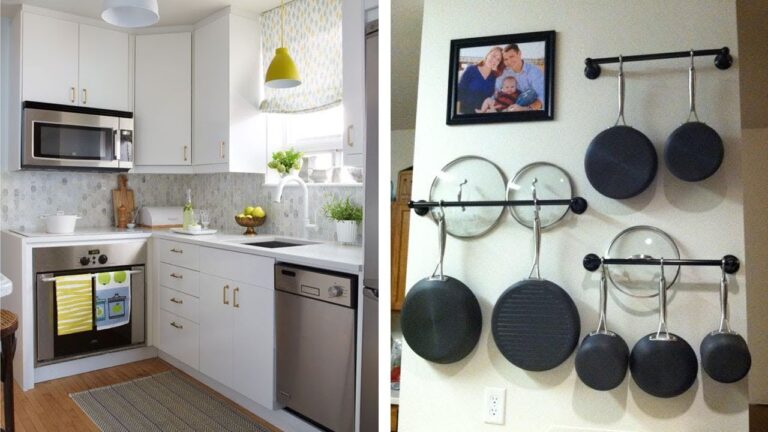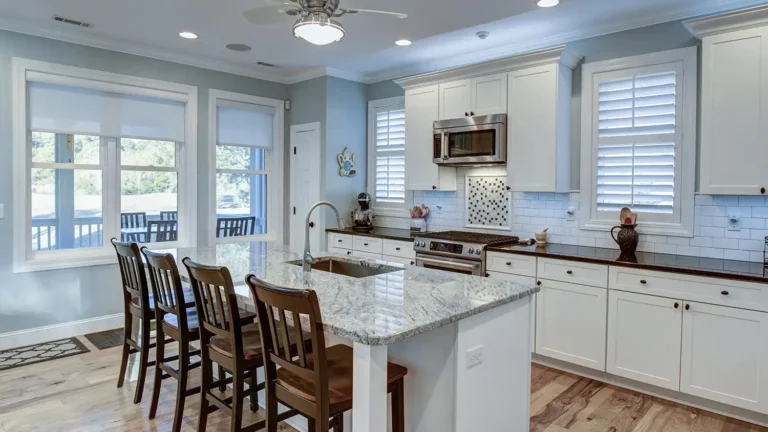How Many Electrical Circuits Are Needed For A Kitchen?
Electrical circuits are an essential component of a kitchen and can be used to power various appliances and fixtures. The number of circuits needed for a kitchen depends on the size and layout of the kitchen, as well as the number and kinds of appliances that will be used. Typically, a kitchen will need at least two circuits: one for general outlets and one for dedicated circuits for large appliances such as a refrigerator, dishwasher, and range. Depending on the size of the kitchen, additional circuits may be needed for lighting, outlets for small appliances, and other fixtures. It is important to consult with a qualified electrician to determine the exact number of circuits needed to ensure the kitchen is properly wired for safety and convenience.
Types of Electrical Circuits in a Kitchen
When it comes to the kitchen, there are a variety of electrical circuits needed to ensure safety and proper functionality. Knowing the types of electrical circuits needed for a kitchen is essential for any renovation or installation project. From countertop outlets to range hoods, here is a closer look at the different types of electrical circuits that are used in a kitchen.
Countertop outlets are typically the most common type of electrical circuit found in kitchens and are used to plug in small kitchen appliances. Range and oven hoods, on the other hand, require a dedicated circuit to ensure that they are properly powered and can handle the higher wattage load. Additionally, refrigerators require their circuit to ensure that they can run efficiently without any issues.
Under-cabinet lighting systems are also commonly used in kitchens and require a dedicated electrical circuit. These lighting systems can be used to illuminate countertops and provide nice accent lighting to any kitchen. Finally, built-in microwaves also require an electrical circuit to ensure that they can run efficiently and safely.
Electrical Circuit Requirements for a Kitchen
Having the right number of electrical circuits for your kitchen is essential to ensure the safe and efficient use of electricity. Whether you are building a new kitchen or renovating an existing one, it is important to understand the electrical circuit requirements for a kitchen. Depending on the size of the kitchen and the appliances you will be using, you may need anywhere from two to five circuits.
It is recommended that all kitchen appliances are connected to separate circuits to help prevent overloads and tripped breakers. Each circuit should have a dedicated circuit breaker to protect the appliance and the wiring from overloads. A kitchen refrigerator should be connected to its separate circuit to avoid interference with other appliances.
For smaller kitchens with only a few appliances, two circuits will generally suffice. Medium-sized kitchens with more appliances may require three or four circuits. Larger kitchens that include many appliances and electronic devices may require up to five circuits. It is best to consult a professional electrician to determine exactly how many circuits are needed for your kitchen.
When it comes to kitchen electrical circuits, safety should always be top priority. Make sure you have the right number of circuits for your kitchen to ensure your family’s safety. With the right number of circuits, you can rest assured that your kitchen appliances will run smoothly and efficiently.
Benefits of Installing Multiple Electrical Circuits
Installing multiple electrical circuits in your kitchen can provide several benefits. By having multiple circuits, you can reduce the risk of overloaded circuits, minimize the need to use extension cords and make it easier to access the power outlets when needed. Furthermore, it can also help you to save energy and money on your electricity bill.
Multiple circuits are especially important for kitchens, as they are often populated with a range of large appliances that draw a lot of power. Installing multiple circuits ensures that each appliance has its dedicated line, reducing the risk of overload and fire hazards. Additionally, multiple circuits can be used to organize the kitchen, providing easy access to outlets that power different appliances.
Finally, installing multiple circuits in your kitchen can help you save energy and money. By dedicating a circuit to each appliance, you can ensure that any unused appliances are not drawing power, resulting in lower electricity bills. In addition, multiple circuits can be used to ensure that the kitchen lights turn off when the room is not in use.
Overall, installing multiple electrical circuits in your kitchen has a variety of benefits. As well as providing more convenience and safety, it can also help you to save energy and money.

Electrical Circuit Installation Process
When renovating your kitchen, one of the most important considerations is the electrical circuit installation process. This is a critical step to ensure that your kitchen is properly powered and that your appliances are running at peak efficiency. To start, it is important to determine how many electrical circuits are needed for your kitchen. Generally speaking, it is recommended to install at least two circuits in your kitchen, with each circuit capable of powering a different set of appliances. This will provide the best balance of safety and convenience.
When it comes to the installation process itself, it begins with the selection of the appropriate circuit breaker. This is usually based on the total wattage of the kitchen appliances that will be powered by each circuit. Once the breaker has been selected, you can begin the wiring process. This involves running the power line through the wall and connecting it to the circuit breaker box. Once the wiring is complete, you can then safely connect the appliances to the circuit.
Finally, it is important to note that proper wiring and circuit installation can be tricky, so it is always recommended to hire a licensed electrician to ensure the job is done correctly. Doing so will help you avoid any potentially dangerous electrical mishaps and will also ensure that your kitchen is properly powered.
Common Mistakes When Installing Electrical Circuits
Installing electrical circuits can be a tricky and dangerous job, so it’s crucial to understand the basics before beginning. Many people make mistakes when it comes to installing electrical circuits, which can lead to costly repairs and even more serious safety issues. To help avoid such mistakes, it’s important to know how many electrical circuits are needed for a kitchen.
When planning out a kitchen’s electrical circuits, the most important factor to consider is the type of appliances that will be used. This will determine how many circuits are necessary to power the kitchen, as well as where to place them. Generally, a kitchen will require at least two circuits for general power, one for the refrigerator, one for the stove, and at least one for the dishwasher. Depending on the type and size of the appliances, even more circuits might be needed.
It’s also important to understand the difference between 120-volt and 240-volt circuits. 120-volt circuits are used for general-purpose outlets, while 240-volt circuits are used for larger appliances such as stoves and dryers. It’s important to make sure the circuit is correctly wired to the correct voltage. Incorrectly wiring a circuit can lead to electrical shock and even fire.
When installing electrical circuits, it’s important to take all safety precautions and follow all local codes. It’s also important to have the knowledge and experience to properly install the circuits, as mistakes can be dangerous and costly. Knowing the number of electrical circuits needed for a kitchen is a great starting point for installing electrical circuits safely and efficiently.
Cost of Installing Electrical Circuits
Installing electrical circuits in your kitchen can be a complex process and can come with a hefty price tag. Depending on the size of your kitchen and the number of appliances, you may need anywhere from one to several electrical circuits. Before taking on this project, it’s important to understand the potential cost of installing electrical circuits in your kitchen.
Labor costs are the biggest factor when it comes to installing electrical circuits. Depending on the complexity of the project, the cost of hiring a professional electrician may range from a few hundred to thousands of dollars. Additionally, the cost of materials such as wire, outlets, and switches must be taken into account. The cost of materials can vary greatly depending on the size of the project and the type of materials being used.
Finally, the cost of permits and inspections must be factored into the overall cost of installing electrical circuits in your kitchen. Depending on your jurisdiction, you may be required to obtain a permit before beginning any kind of electrical work. Additionally, inspections may be required after the job is complete to ensure that the work is done properly. The cost of permits and inspections may vary from a few hundred dollars to several hundred dollars, depending on the scope of the project.
FAQs About the How Many Electrical Circuits Are Needed For A Kitchen?
1. How many outlets and circuits does a kitchen need?
Answer: According to the National Electrical Code, a kitchen must have at least two 20-amp circuits, one for general lighting and receptacle outlets and one exclusively for the refrigerator. Additional circuits may be needed for a dishwasher, garbage disposal, microwave, or other appliances.
2. What is the difference between a circuit and an outlet?
Answer: A circuit is a closed loop of wiring that connects a power source to a load, such as an appliance or light fixture. An outlet is a point of connection within a circuit, allowing the user to plug in and use an appliance or other device.
3. Are GFCI outlets required in a kitchen?
Answer: Yes, all outlets in a kitchen must be Ground Fault Circuit Interrupter (GFCI) outlets. These outlets are designed to shut off electricity if a short circuit, ground fault, or overload is detected. GFCI outlets provide additional protection against shock and fire.
Conclusion
A kitchen typically requires at least three electrical circuits to provide enough power for the various appliances and fixtures. One circuit is typically dedicated to large appliances, one to the lighting, and one to the receptacles. Depending on the size and layout of the kitchen, more circuits may be needed to accommodate all the fixtures and appliances. With careful planning and installation, electrical circuits can be added to ensure that the kitchen has enough power for all its needs.





